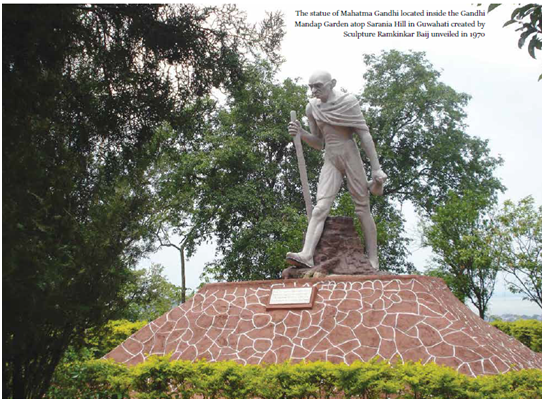
Well-known as “Father of the Nation”, Mahatma Gandhi’s all the four visits to the then compact Assam was literally an epoch-making event in the political history of the State. Historically speaking, he paid four visits to Assam. He visited the State at a time when the national movement across the country was at its zenith. Significantly, every time he visited the state, he came across an agenda of doing some constructive and valuable works successfully done through his colleagues within Assam as also those from other parts of the country.
It will not be irrelevant to mention here Mahatma Gandhi’s visit to the Northeast prior to the country’s independence was mainly confined to Assam because at that time Assam was necessarily a large province which was made up of the then North-East Frontier Agency, (present Arunachal Pradesh), the Lushai hills( at present known as Mizoram), the Naga Hills and Tuensang district (formed as the State of Nagaland in1963), and the Khasi and Jaintia hills ( now known as Meghalaya). Gandhiji may have undertaken an extensive tour of all the regions of the then undivided Assam. But possibly due to his preoccupation with the national liberation movement, he could not do so.
Even then, during his Assam tour, he did some laudable works in the Northeasts through his lieutenants in the state as also those from other parts of the country. For instance, he was instrumental during his tour to motivate the leading personalities of Assam to set up “Rastrabhasha Prachar Samity”. He encouraged his colleagues to form the Naga Peace Mission in Nagaland. Two members of the Mission were JP and B P Chaliha – both incidentally the followers of Gandhiji. His one of the vital roles was to lead the Assam Congress geographically to integrate the Northeast to Independent India.
However, Gandhiji first visited Assam in 1921. During his whirlwind tour spanning seven days, he visited a number of places such as Tezpur, Nagaon and Dibrugarh. He indeed arrived in Guwahati earlier on August 18. He then left for Cachar-Sylhet via Lumding on August 26, 1921. He came to Assam at the invitation of Assam Congress leaders who had formed the Assam Congress in Guwahati under Late Kuladhar Chaliha as its President made two months earlier than his visit to Assam, on June 5, 1921. Gandhiji during his stay propagated the message of non-violent, non-cooperation movement aimed at shunning off foreign goods among the people in the State. His visit roused high hopes in the minds of tea garden labourers and they had extended their support to the non-cooperation movement. The progress of the movement led to a strong feeling of panic in the minds of the British colonial tea planters.
Mahatma Gandhi’s second visit to Assam, however, took place in 1926. Initially he was a little hesitant about going there once again, because there was basically no crucial assignment to perform in Guwahati. But finally he had to come to the city under the mounting pressure from the State Congress party leaders on account of the Congress session at Pandu. On his arrival here, he was highly impressed by the lack of grandeur of the Congress party. At that time, the total population of the city was approximately 16 thousand. Generally, a town/city that has less number of population, will never dare to hold such an All-India session. But the party leaders held it in the midst of natural beauty all around in a big way on the bank of the massive Brahmaputra, flowing along the city majestically, which drew huge. audience. 
To read the further articles please get your copy of Eastern Panorama October issue @http://www.magzter.com/IN/Hill-Publications/Eastern-Panorama/News/ or mail to contact @easternpanorama.in


